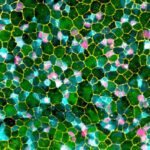Lien vers Pubmed [PMID] – 26538650
J. Neurosci. 2015 Nov;35(44):14794-808
UNLABELLED: Modulation of connectivity formation in the developing brain in response to external stimuli is poorly understood. Here, we show that the raphe nucleus and its serotonergic projections regulate pathfinding of commissural axons in zebrafish. We found that the raphe neurons extend projections toward midline-crossing axons and that when serotonergic signaling is blocked by pharmacological inhibition or by raphe neuron ablation, commissural pathfinding is disrupted. We demonstrate that the serotonin receptor htr2a is expressed on these commissural axons and that genetic knock-down of htr2a disrupts crossing. We further show that knock-down of htr2a or ablation of the raphe neurons increases ephrinB2a protein levels in commissural axons. An ephrinB2a mutant can rescue midline crossing when serotonergic signaling is blocked. Furthermore, we found that regulation of serotonin expression in the raphe neurons is modulated in response to the developmental environment. Hypoxia causes the raphe to decrease serotonin levels, leading to a reduction in midline crossing. Increasing serotonin in the setting of hypoxia restored midline crossing. Our findings demonstrate an instructive role for serotonin in axon guidance acting through ephrinB2a and reveal a novel mechanism for developmental interpretation of the environmental milieu in the generation of mature neural circuitry.
SIGNIFICANCE STATEMENT: We show here that serotonin has a novel role in regulating connectivity in response to the developmental environment. We demonstrate that serotonergic projections from raphe neurons regulate pathfinding of crossing axons. The neurons modulate their serotonin levels, and thus alter crossing, in response to the developmental environment including hypoxia. The findings suggest that modification of the serotonergic system by early exposures may contribute to permanent CNS connectivity alterations. This has important ramifications because of the association between premature birth and accompanying hypoxia, and increased risk of autism and evidence associating in utero exposure to some antidepressants and neurodevelopmental disorders. Finally, this work demonstrates that the vertebrate CNS can modulate its connectivity in response to the external environment.

